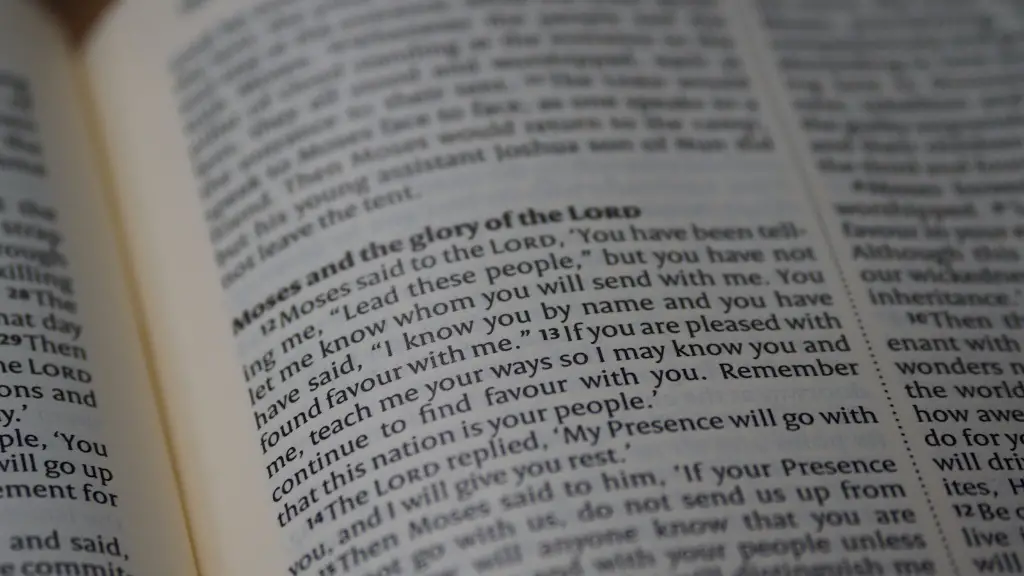Basic Guidelines
Every reader should follow the basic guidelines in order to understand the Bible. The first guideline is to read the Bible in chronological order. So, if possible, start from the Book of Genesis, then move chronologically across the Old Testament, and finally on to the New Testament and the Gospels. This will help you gain a better understanding of how the different stories fit together and will give you a better grasp of the overarching narrative of the Bible.
The second guideline is to have patience when reading the Bible. As with all long texts, there are moments in the Bible that can seem unimportant or unnecessary. It might even feel like you’ve read the same verse more than once. But every part of the story is important and will help you understand the bigger picture. So it’s important to take your time and take it slow.
The third and final guideline is to try and start with a specific book of the Bible. While reading it chronologically is helpful, it can be hard to jump right into the Bible when you don’t know what to expect. So if possible, find a book that speaks to you and start there. This can help you find your footing in the Bible and work your way outwards as you get more comfortable.
Interpretation
Once you’re familiar with the basic guidelines, the next step in learning how to read the Bible is to learn how to interpret it correctly. Interpretation is essential in order to understand the message that the Bible is trying to communicate. A helpful way to interpret the Bible is to look at the context of the stories and the characters involved. By looking at the context, you can gain a better understanding of how the passage might be interpreted. Look at the culture, the environment, and the characters, and then consider how the message might be interpreted by someone living in that same culture.
Another helpful technique is to read different translations of the Bible. While some people prefer to read the original source material, looking at translations can also be helpful. It will give you a more holistic view of the passage and help you to have an informed opinion of the text. Each translation can emphasize different points and provide its own perspective on the stories.
Finally, it’s important to discuss the passage with other people who are also reading the Bible. This will allow you to bounce ideas off each other, get different opinions, and gain better insight into the passage. It can also help to have someone to talk to if you ever get stuck or don’t understand something.
Resources
In addition to the Bible itself, there are many helpful resources available that can help supplement your Bible reading. These resources can include commentaries, devotionals, and even interactive apps that can help guide you through a book of the Bible. These resources can be incredibly helpful for those who are just starting out, or for those who need a little extra help with the text.Another great resource is joining a Bible study group. This is a great way to discuss the passages and get feedback from others. It can also be an avenue for finding other translations of the Bible and for discovering new commentaries and resources. No matter what type of resource you choose, it’s important to take initiative to learn and seek out helpful materials that will enrich your understanding of the text.
Theology and Doctrine
When it comes to reading and interpreting the Bible, some readers might also consider their theological beliefs and doctrines. While reading and discussing the Bible, some people might go down the road of trying to find proof-texts that support their own beliefs, dividing texts into “true” and “false,” and reducing the text to a book of rules. This kind of approach, while understandable, will likely lead to an unbalanced view of the Bible and a limited understanding of what it is actually saying.
Instead, it is better to read the Bible from a holistic perspective. This means considering the overarching themes within the Bible: mercy, justice, sin, redemption, etc. This type of approach allows for both concrete and abstract truths to be recognized within the text, as well as for different interpretations to be discussed and explored. This type of approach will ultimately lead to a greater understanding of the Bible and its messages.
Study and Prayer
Finally, when it comes to learning how to read the Bible, it’s important to understand that it requires both study and prayer. Study requires time and effort, which often means setting aside a proper amount of time to read and interpret the Bible. Prayer is also an essential part of Bible reading. Praying for guidance and understanding will open the door to a deeper understanding of the text and will provide an avenue for grace and insight.
Conclusion
Reading the Bible can be a challenging but rewarding experience. It requires patience, practice, and a willingness to learn. But by following the basic guidelines, utilizing various resources, studying the text, and praying for guidance, any reader can gain a better understanding of the Bible and the truths it contains.

